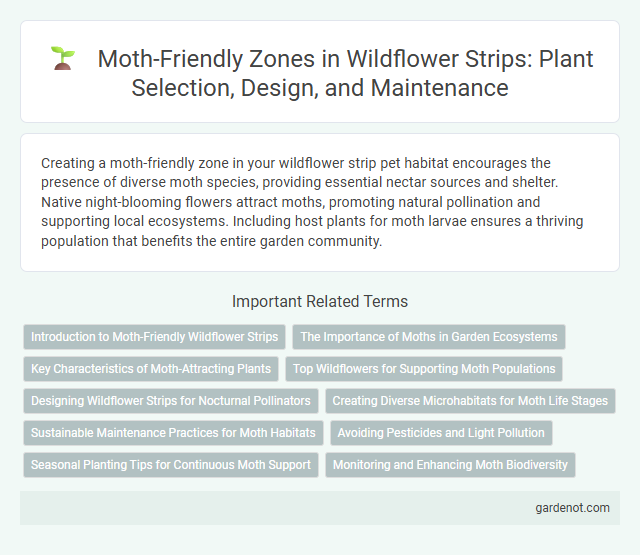Creating a moth-friendly zone in your wildflower strip pet habitat encourages the presence of diverse moth species, providing essential nectar sources and shelter. Native night-blooming flowers attract moths, promoting natural pollination and supporting local ecosystems. Including host plants for moth larvae ensures a thriving population that benefits the entire garden community.
Introduction to Moth-Friendly Wildflower Strips
Moth-friendly wildflower strips provide essential habitats that support diverse moth populations by offering nectar sources and host plants for caterpillars. These strips contribute to maintaining ecological balance and promoting biodiversity within agricultural and urban landscapes. Implementing native wildflower species tailored to local moth preferences enhances conservation efforts and pollination services.
The Importance of Moths in Garden Ecosystems
Moth-friendly zones within wildflower strips support biodiversity by providing essential nocturnal pollinators that sustain many plant species. Moths contribute to garden ecosystems through pollination and serve as a vital food source for birds, bats, and other wildlife. Encouraging moth habitats ensures ecological balance and enhances the health of diverse garden environments.
Key Characteristics of Moth-Attracting Plants
Moth-attracting plants in wildflower strips typically possess pale or white flowers that reflect moonlight, enhancing nocturnal visibility. These plants emit strong, sweet fragrances during dusk and nighttime, which are critical for moths' navigation and attraction. Nectar-rich blossoms with accessible shapes support diverse moth species by providing essential feeding resources in their habitats.
Top Wildflowers for Supporting Moth Populations
Planting a wildflower strip rich in native species like evening primrose, honeysuckle, and cow parsley creates an ideal moth-friendly zone that supports diverse moth populations. These wildflowers provide essential nectar sources and larval host plants, boosting moth biodiversity and aiding pollination. Maintaining such habitats promotes ecological balance by sustaining local food webs and enhancing nocturnal pollinator activity.
Designing Wildflower Strips for Nocturnal Pollinators
Designing wildflower strips for nocturnal pollinators involves selecting native flowering plants that bloom in the evening and emit strong, sweet fragrances to attract moths. Species such as evening primrose (Oenothera biennis), moonflower (Ipomoea alba), and night-blooming jasmine (Cestrum nocturnum) provide essential nectar sources for moths, supporting biodiversity and enhancing ecosystem services. Incorporating dark, sheltered habitats near the strip also encourages moth activity and successful pollination during nighttime hours.
Creating Diverse Microhabitats for Moth Life Stages
Creating a wildflower strip enhances moth-friendly zones by providing diverse microhabitats that support various moth life stages, including egg-laying sites, larval feeding areas, and safe pupation spots. Incorporating plant species with staggered bloom times and varying structures promotes biodiversity and sustains moth populations throughout their life cycles. These microhabitats also attract natural predators and pollinators, contributing to a balanced ecosystem.
Sustainable Maintenance Practices for Moth Habitats
Wildflower strips create essential moth-friendly zones by providing diverse nectar sources and shelter, promoting biodiversity. Sustainable maintenance practices include minimal mowing during peak moth activity seasons and avoiding pesticides to preserve larval food plants. Incorporating native wildflowers ensures habitat resilience, supporting healthy moth populations and ecological balance.
Avoiding Pesticides and Light Pollution
Creating a moth-friendly wildflower strip requires eliminating pesticide use to protect native moth populations and ensure the survival of their larvae. Minimizing artificial light pollution preserves nocturnal habitats, allowing moths to navigate, feed, and reproduce naturally. Incorporating native plants that bloom at night further supports diverse moth species by providing essential nectar sources.
Seasonal Planting Tips for Continuous Moth Support
Plant a diverse mix of native wildflowers like evening primrose, asters, and goldenrod to provide nectar throughout spring, summer, and fall for moth populations. Incorporate host plants such as bedstraw, willow, and oak trees to support larval feeding stages and encourage moth breeding. Stagger planting times and include late-blooming species to maintain a continuous food supply and shelter, promoting year-round moth activity in the wildflower strip.
Monitoring and Enhancing Moth Biodiversity
Regular monitoring of moth populations in wildflower strips provides critical data on species diversity and abundance, enabling targeted conservation efforts. Utilizing light traps and pheromone lures ensures effective tracking of nocturnal moth activity, revealing population trends and habitat preferences. Enhancing moth biodiversity involves planting native flowering plants that offer continuous nectar sources and larval host plants, supporting multiple moth life stages and promoting ecosystem resilience.
Moth-friendly zone Infographic

 gardenot.com
gardenot.com